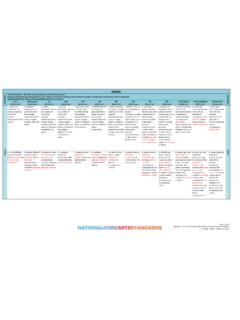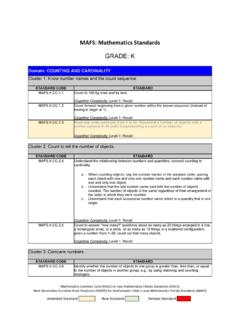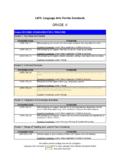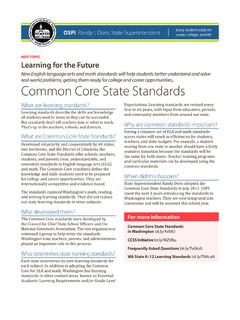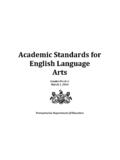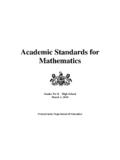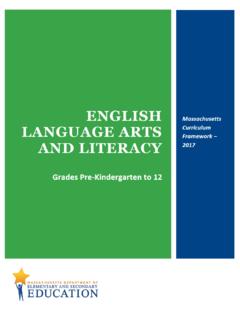Transcription of The Arts and the Common Core - National Core …
1 The arts and the Common core :A Review of Connections Between the Common core State standards and the National core arts standards Conceptual FrameworkPrepared by the College Board for the National Coalition for core arts standards December 2012 2 December 2012 The College Board Office of Academic Initiatives 45 Columbus Avenue New York, NY 10023-6992 National Coalition for core arts standards 800-587-6814 Prepared by: Amy Charleroy, Office of Academic Initiatives, The College Board, New York Individuals are encouraged to cite this report and its contents. In doing so, please include the following attribution: The College Board, The arts and the Common core : A Review of Connections Between the Common core State standards and the National core arts standards Conceptual Framework, New York, , December 2012. 3 Table of Contents Executive Summary .. 4 Overview of Alignment: Common core Introductory Materials.
2 18 Anchor standards for Reading .. 19 Anchor standards for Writing .. 20 Anchor standards for Speaking and Listening .. 21 Anchor standards for Language .. 22 standards for Mathematical Practice .. 23 Full Alignment Charts: Common core Introductory Material .. 25 Anchor standards for Reading .. 32 Anchor standards for Writing .. 44 Anchor standards for Speaking and Listening .. 53 Anchor standards for Language .. 59 standards for Mathematical Practice .. 62 Appendix A: College and Career Readiness Anchor standards for English Language arts .. 68 Appendix B: standards for Mathematical Practice .. 70 References .. 73 4 Executive Summary Drawing from the strongest models of state standards nationwide, the Common core State standards for English Language arts and Mathematics were released in mid-2010, and they have been quickly adopted by almost all 50 states . The stated mission of this initiative is to provide a consistent, clear understanding of what students are expected to learn, so teachers and parents know what they need to do to help them.
3 The standards are designed to be robust and relevant to the real world, reflecting the knowledge and skills that our young people need for success in college and career. ( Common core State standards Initiative, 2010) While a specifically arts -focused branch of the Common core standards does not exist, and these standards are not intended to replace arts -specific benchmarks, there is evidence in the standards documents that Common core goals and objectives are meant to apply to subjects outside of the realm of ELA and math. The introduction to the Common core standards for English Language arts advises that the literacy standards for grade 6 and above are predicated on teachers of ELA, history/social studies, science, and technical subjects using their content area expertise to help students meet the particular challenges of reading, writing, speaking, listening, and language in their respective fields.
4 ( Common core State standards Initiative, 2010a) The term technical subject includes the arts , and it is defined by the standards as [a] course devoted to practical study, such as engineering, technology, design, business, or other workforce-related subject; a technical aspect of a wider field of study, such as art or music. ( Common core State standards Initiative, 2010b) Since the 2010 publication of the standards , arts educators and advocates have publically discussed the relationship between this set of expectations and teaching and learning in the arts . How do the Common core standards relate to the goals of arts education, and what does Common core -aligned arts instruction look like? In an effort to address these questions, one of the Common core s authors developed a document titled Guiding Principles for the arts , applying ELA goals and themes to arts -based learning.
5 Among his recommendations are for arts teachers and students to engage in deep, sustained study of a limited number of works of art (paralleling the ELA standards recommendation of studying fewer texts in greater depth), and to utilize the arts as powerful tools to develop and refine skills of observation and interpretation that are a cornerstone of the Common core . (Coleman, 2011). arts advocates have echoed this recommendation, emphasizing the idea that visual literacy is a component of overall literacy, and that responding thoughtfully and critically to a painting, film, or performance hones the same skills of analysis and interpretation that are strengthened by the close reading of a text. (Zuckerman, 2012; Munson, 2012). This argument suggests that aligning arts education with Common core objectives may not detract from arts instruction and impose additional expectations on arts teachers; rather, the Common core can potentially provide arts teachers with a Common language with which to describe the cognitive skills that they are already addressing and cultivating through rigorous and meaningful arts experiences.
6 The National Coalition for core arts standards (NCCAS) is currently spearheading the revision of the National standards for arts education for the first time since their creation in 1994, and this presents a significant opportunity to highlight the overlap between the Common core s objectives and the practices of arts -based learning. Given the central role that the Common core standards are playing in education and school reform initiatives nationwide, it is a priority of the Coalition to ensure that the goals and objectives of the core arts standards relate clearly, directly, and meaningfully to the Common core , and that these connections are actively considered as a part of the standards writing process. In an effort to inform the work of the standards writers, College Board researchers undertook a study of the Common core standards as they relate to arts -based learning.
7 5 Methodology In considering methods for measuring the alignment between the Common core standards and the core arts standards , the first steps were to identify what could be implied by the term alignment, and to identify which elements of the Common core standards and the documents informing the core arts standards may prove most useful for comparison. After considering several possibilities, the research was carried out in two phases, each associated with a different approach to alignment and a different methodology for analysis. The first phase was focused on finding examples of arts -based content and examples already present in the Common core standards a content-based alignment study and the second aimed to identify areas of overlap between the skills and habits emphasized in the Common core standards and in the framing materials that will shape the content of the core arts standards .
8 A description of the methods employed in each phase follows. Phase I: Content-based alignment In the first portion, researchers identified explicit arts references already present in the Common core State standards . This analysis is essentially an inventory of the instances in which the arts are mentioned in the Common core standards for English Language arts . A particular standard may recommend that students read a play, for example, or respond to a performance, and it is examples such as these that were recorded in this phase of research. An explanation of the structure of the Common core standards may assist in clarifying the approach to this phase of research. The Common core State standards for English Language arts are divided into four sections: Reading, Writing, Speaking and Listening, and Language. Each section contains a series of College and Career Readiness Anchor standards overarching standards that apply to all grade levels.
9 The full text of all College and Career Readiness Anchor standards is available in Appendix A of this document. Each anchor standard has a corresponding grade-level standard, defining what it means for students to meet that standard in a grade-level-appropriate way. In the case of the standards for Reading, the grade-level standards are further divided into two categories: Reading standards for Literature and Reading standards for Informational Text. For illustration, the following table highlights a selection of grade-level Reading standards for Literature that relates to Anchor Standard 1 for Reading: Common core standards for English Language arts Anchor standards for Reading Anchor standards for Writing Anchor standards for Speaking and Listening Anchor standards for Language Grade-level standards : Literature Grade-level standards : Informational Text Grade level standards Grade-level standards Grade-level standards 6 Anchor Standard for Reading #1: Read closely to determine what the text says explicitly and to make logical inferences from it; cite specific textual evidence when writing or speaking to support conclusions drawn from the text.
10 Corresponding grade-level Reading standards for Literature Kindergarten With prompting and support, ask and answer questions about key details in a text. Grade 5 Quote accurately from a text when explaining what the text says explicitly and when drawing inferences from the text. Grade 8 Cite the textual evidence that most strongly supports an analysis of what the text says explicitly as well as inferences drawn from the text. Grade 12 Cite strong and thorough textual evidence to support analysis of what the text says explicitly as well as inferences drawn from the text, including determining where the text leaves matters uncertain. The first phase of research involved an examination of all four groups of College and Career Readiness Anchor standards for English Language arts , and all of their corresponding grade-level standards , noting specific references to the arts present in these standards , including examination and discussion of works of art (including dance, theatre, or music performances, works of visual art and media arts , and written dramas), as well as the creation of original works by students.
